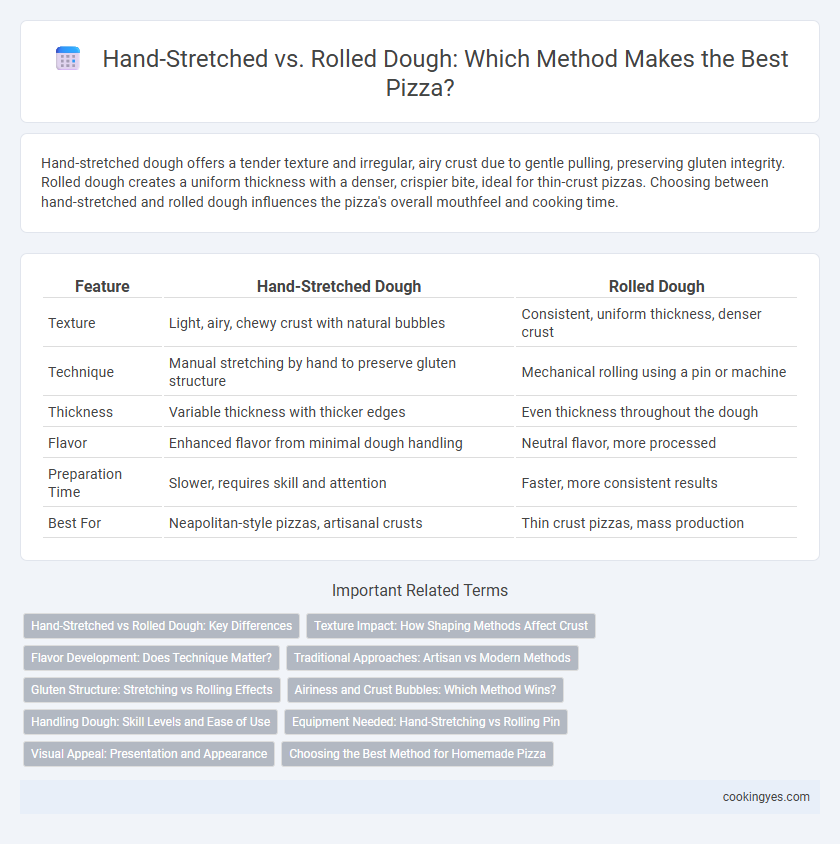Hand-stretched dough offers a tender texture and irregular, airy crust due to gentle pulling, preserving gluten integrity. Rolled dough creates a uniform thickness with a denser, crispier bite, ideal for thin-crust pizzas. Choosing between hand-stretched and rolled dough influences the pizza's overall mouthfeel and cooking time.
Table of Comparison
| Feature | Hand-Stretched Dough | Rolled Dough |
|---|---|---|
| Texture | Light, airy, chewy crust with natural bubbles | Consistent, uniform thickness, denser crust |
| Technique | Manual stretching by hand to preserve gluten structure | Mechanical rolling using a pin or machine |
| Thickness | Variable thickness with thicker edges | Even thickness throughout the dough |
| Flavor | Enhanced flavor from minimal dough handling | Neutral flavor, more processed |
| Preparation Time | Slower, requires skill and attention | Faster, more consistent results |
| Best For | Neapolitan-style pizzas, artisanal crusts | Thin crust pizzas, mass production |
Hand-Stretched vs Rolled Dough: Key Differences
Hand-stretched dough preserves more air bubbles, resulting in a lighter, chewier crust with a delicate texture, while rolled dough tends to be denser and more uniform due to the compression of the gluten network. Hand-stretching allows for better control over dough thickness and promotes a more artisan look with irregular edges, whereas rolling produces a consistent thickness ideal for thin-crust pizzas. The choice between hand-stretched and rolled dough directly influences the crust's texture, bite, and overall pizza quality.
Texture Impact: How Shaping Methods Affect Crust
Hand-stretched dough creates a more airy and chewy crust due to gentle stretching that retains gas bubbles, enhancing texture and flavor complexity. Rolled dough typically produces a denser, thinner crust with a uniform thickness, sacrificing some lightness for a crispier bite. The shaping method directly influences crust elasticity and mouthfeel, impacting the overall pizza experience.
Flavor Development: Does Technique Matter?
Hand-stretched dough preserves air bubbles within the crust, promoting better fermentation and a more complex, tangy flavor due to slower oxygen exposure. Rolled dough compresses the gluten structure and reduces gas retention, leading to a denser texture with less nuanced flavor development. This technique impacts yeast activity and enzymatic reactions, making hand-stretching superior for enhanced taste and aroma in artisanal pizza crusts.
Traditional Approaches: Artisan vs Modern Methods
Hand-stretched pizza dough preserves the traditional artisan quality by allowing gentle, controlled shaping that maintains gluten structure and creates a light, airy crust with characteristic irregular edges. Rolled dough, favored in modern methods, offers uniform thickness and faster preparation but often results in a denser texture due to compressed gluten. Artisanal hand-stretching emphasizes craftsmanship and texture, while rolling caters to efficiency and consistency in high-volume pizza production.
Gluten Structure: Stretching vs Rolling Effects
Hand-stretched dough maintains an open gluten structure by gently elongating gluten strands without breaking them, resulting in a chewier, more elastic crust. Rolled dough compresses and flattens gluten strands, which often leads to a denser, less airy texture and a tougher bite. This difference in gluten integrity directly impacts the pizza's overall texture and chewiness.
Airiness and Crust Bubbles: Which Method Wins?
Hand-stretched pizza dough typically achieves superior airiness and more prominent crust bubbles compared to rolled dough, due to its gentle manipulation preserving gas pockets within the dough structure. Rolling the dough often compresses these air pockets, resulting in a denser, less airy crust with fewer bubbles. For an airy texture and visually appealing, bubbly crust, hand-stretching remains the preferred dough forming method among pizza experts.
Handling Dough: Skill Levels and Ease of Use
Hand-stretched dough requires advanced skill to achieve the ideal thin, elastic crust without tearing, offering superior texture and flavor development through gentle stretching. Rolled dough provides a more consistent thickness and shape with less training, making it ideal for beginners or high-volume kitchens seeking efficiency. Each method impacts gluten structure differently, affecting chewiness and crust rise, influencing the overall pizza quality based on operator expertise.
Equipment Needed: Hand-Stretching vs Rolling Pin
Hand-stretched pizza dough requires minimal equipment, primarily relying on skilled manual stretching to achieve a thin, airy crust with a light texture. Using a rolling pin for dough forming demands a flat, clean surface and the pin itself, which applies uniform pressure, resulting in a denser crust with less air trapped inside. Professional pizzerias often prefer hand-stretching tools like dough trays and proofing baskets, while home cooks rely on rolling pins and pastry mats for convenience.
Visual Appeal: Presentation and Appearance
Hand-stretched pizza dough creates a rustic, artisanal look with uneven edges and natural air bubbles that enhance visual appeal and signal a traditional baking method. Rolled dough forms a uniform, perfectly round crust with consistent thickness, offering a polished and professional appearance ideal for gourmet presentations. The choice between hand-stretched and rolled dough directly influences the pizza's aesthetic, impacting customer perception and dining experience.
Choosing the Best Method for Homemade Pizza
Hand-stretched dough preserves air bubbles, creating a lighter, chewier crust with more flavor complexity favored in traditional Neapolitan pizza. Rolled dough offers uniform thickness and faster preparation, ideal for consistent cooking and crispy texture preferred in New York-style pizza. Selecting the best method depends on desired crust texture, cooking time, and personal taste preferences for homemade pizza.
Hand-stretched vs Rolled for dough forming Infographic

 cookingyes.com
cookingyes.com